Link building has undoubtedly become one of the cornerstones of SEO (Search Engine Optimization). Whenever we build a website, we start seeking recognition for it, don’t we? That’s even the whole point of all our efforts. We want to increase our visibility in order to reach our desired ranking on SERPs (search engine results pages). Backlinks are one of the main elements that act as connectors, ensuring that our website draws attention.
What about you? How are you doing with your link crafting activities? If you think that it’s quite demanding work, we totally understand. That’s why our topic of the day is link-building checklists. This kind of tool can assist you in making things more organized and keeping your link collection always up-to-date. Keep scrolling to find out more about it.
What Is Link Building?
Link building is an SEO, search engine optimization strategy that enables users to navigate through links from another website to yours. In other words, it is simply using links directing to your website on other websites. These hyperlinks are often called “backlinks” or simply “links”. They serve as pathways leading from one web page to another. Link building is a fundamental factor of SEO because search engines use these links to evaluate a website’s credibility and relevance.
Why Is Link Building Important?
Backlinks are important as search engines like Google consider them as one of the ranking factors. So, if you want to rank higher on the SERPs, you may want to take link building job seriously. Search engines consider those links as “votes of confidence”. These votes are crucial because, with those, search engines decide to rank which page is higher when something related to those is asked by users. Thus, as a result, we can say that pages with more backlinks tend to rank higher on the result pages.
How to Build Links
If we are on the same page about the importance of link building, now we can talk about the link building tactics that will ease your job. Link building can be divided into several methods, including asking for links, adding links, earning links, and even buying links. Additionally, preserving existing links is significant to maintain the quality of your website.
Start by Downloading a Sheet
It sounds obvious, right? As you need to follow your building strategies closely, you should start by downloading a checklist. You may then modify and revise it to your convenience. There’s, for example, a model provided by Google Sheets that you can download and use. There are also a few others available for free on the internet.
Indeed, even if we are about to give you a checklist model in this article, nothing is 100% immutable. You may need or want to add, remove, or modify certain elements. Personalized material can even motivate you while spending time on the tasks. So at the end of the day, it’s a matter of preferred style too.
Chase Link Building Opportunities
No secret here: Link building is, above all, a matter of taking the initiative. The outcome of your link-building campaigns will depend on how well and how much you seize every potential opportunity on your way. Here are some of the objectives that you should incorporate into your checklist and then materialize:
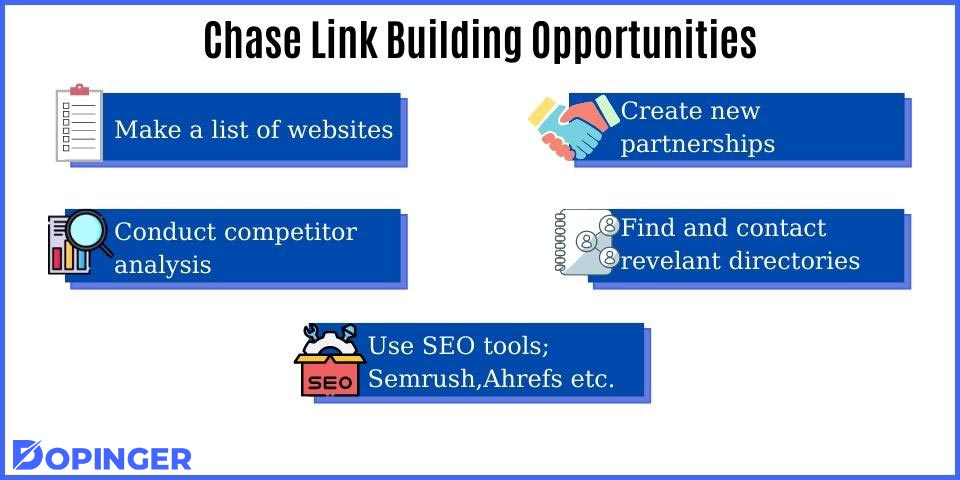
- Make a list of websites where you can obtain guest posting opportunities.
- Conduct competitor analysis and figure out their link sources.
- Join an affiliate marketing program in order to broaden your contacts list and create new partnerships.
- Find and contact relevant directories.
- Use SEO tools (Semrush, Ahrefs, Moz Pro, etc.) to receive additional guidance on link-building strategies.
Be aware that the above list is not exhaustive and that you won’t have to do everything on it at once. Those tips are useful mostly when you begin your link-building journey. However, you will need to apply them afterward as well and possibly on a regular basis. Why? Because nothing lasts forever, as they say. The links you get are not eternal, and the business world is subject to constant change. So you will definitely have to sustain your efforts in the long term. That’s, for example, the case of competitor backlink analysis. Especially if you work on link building for an e-commerce website, you should consider these analyses.
Stay Cautious about Your Sources
That’s a fact: The online environment is prone to all sorts of scams. You don’t want these to ruin your hard work. Thus, you must carefully assess your backlink sources and ensure they are reliable.
- Always go for niche-relevant sources, meaning that the best links are those gotten from those from businesses belonging to the same niche as you. Try to get quality backlinks.
- Verify the domain authority (DA) score of the websites you intend to work with.
- Make sure that the sites in question are not blacklisted in any way.
- Conduct a content analysis. Assess the quality, relevance, and exemption from spam.
- Beware of link farming and avoid any suspected website.
- Prioritize websites that have high levels of organic traffic.
- As said previously, find out any guest posting/blogging opportunities.
Clean Up Your Backlink Portfolio Regularly
What do we mean? The precondition of a perfect link-building SEO roadmap is… to keep the road clean. You don’t want obsolete, incomplete, or defective material to create useless obstacles between you and the search engine podium. So do apply the following diligently:
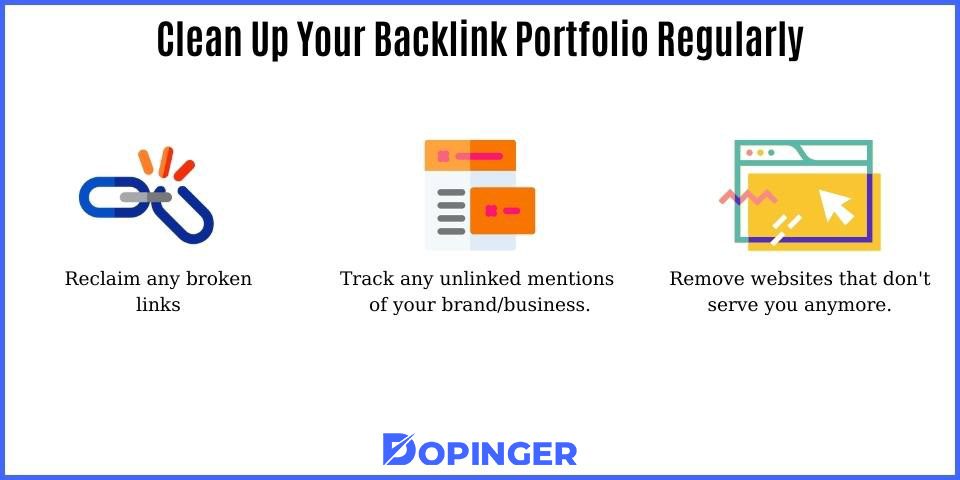
- Reclaim any broken link and provide updated ones instead.
- Track any unlinked mentions of your brand/business. If you find any, do your best to get them linked as soon as possible.
- Keep an eye on your disavow file. Remove websites that don’t serve you anymore and add new ones if necessary.
So one of the key ingredients is to take care of your links. You can’t just obtain them randomly and then walk away. Adopt them as any other essential task of your daily SEO practice. Because really, that’s what link building is all about.
Create the Right Content for Your Links
Your links are not here to point to thin air. There must be tangible and preferably high-quality content backing them. Indeed, no one, not even your closest friends, would distribute backlinks for nothing, correct? Content creation is probably one of the phases on which you will need to spend the most time and energy. Here’s how you can proceed:
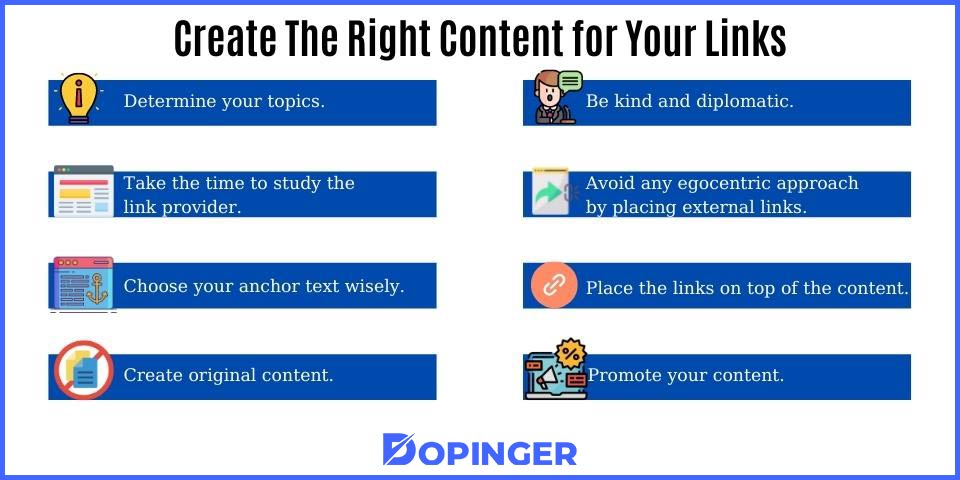
- Determine your topics. Assess their relevance and possible interest for your link providers (people won’t link to anything they don’t have a minimum interest in).
- Take the time to study your link provider (aka target website). What are their guidelines? What kind of material do they publish?
- Choose your anchor text wisely. That’s where you will add your link.
- Create original content. Avoid plagiarism by using plagiarism checker tools, and if you really need to quote someone else, please give them the appropriate credits on your page.
- Be kind and diplomatic. Return the favor by adding internal links to your provider(s) on your own site.
- The same goes for other sources. Avoid any egocentric approach by placing external links on your site.
- It’s usually best to place the links on the top of the content instead of at the end… just in case some people don’t read the whole content!
- You should research how to promote your blog and promote your content for finding new contact.
Ask for Links
Asking for links is basically contacting websites and asking them to link your webpage or website to their content. You can reach out to them through email or social media and politely make a request. You can also talk about why they should mention you on their website, giving examples of benefits, and so on. If they have any broken links, you can ask them to replace the link with one of your related content. Here is a list of some strategies you can use to ask for links:
- Guest blogging – Write for their website and create a backlink to your website.
- Skyscraper technique – Advise them on a better resource than the one they use.
- Ego bait – Mention them in your content before they mention you.
- Testimonials and case studies – Give positive feedback and reviews about their products.
- Link exchanges – Offer mentioning and linking each other one by one.
- Broken link building – Help them change a broken link with a new one, preferably yours.
- Image link building – Request them to give credit for using your image.
Add Links
Adding links refers to going to social media accounts or other websites and adding your webpage link manually, maybe by commenting or sharing it. You can share your link on forums, social media posts, blog articles, etc. Even though it seems like the easiest way of link building, it is not the most effective one. Generally, search engines do not consider those links since you create them yourself. In other words, you simply bombard every place you find with your link, and search engines think of those as if disturbing the credibility while deciding on the ranking. Hence, it might look simple, but we cannot say it will give you the best result you want.
Earn Links
Earning links means that other websites link you without even asking them first. We know it seems hard, but it is not impossible. With little techniques, your content can also be linked to other websites.
The first thing you can do is create high-quality content. Producing high-quality, exceptional content can make you stand out in your niche and earn you credibility. Hence, you can be a resource for other sources without asking them to link your content. Informative articles and research studies are usually examples of the most linked types of content.
The second thing you can do is promote your content on your social media platforms. You can share your content on social media accounts and engage with your audience. When your content gains traction and visibility, it’s more likely to be linked to by others.
Buy Links
To buy links, you can consider sponsored content opportunities. In sponsored content, you will pay a little money to have your content published on another website with a backlink to your site. However, it is our responsibility to warn you that you should be sure about such arrangements obeying search engine guidelines.
Preserve Links
When you add or earn links, your job is not done. You also need to protect and preserve your existing links to maintain your visibility with your rankings. In order to be sure about your backlinks, you can regularly monitor them to ensure they are still alive and relevant. You can use tools like Google Search Console or third-party backlink analysis tools for monitoring your backlinks.
Moreover, if you find broken or incorrect backlinks used before, you can contact the linking websites and request them to update the links. This can help you to maintain the integrity and credibility of your website while protecting its being current and up-to-date.
What Makes a Good Backlink?
Of course, we say backlinking is good and beneficial for your SEO efforts, but there are criteria that determine what is a good backlink and what is a bad one. Even though we don’t know what Google’s criteria are for assessing links, we believe they are divided into six categories. Let’s talk about the features of good link building that will increase the organic traffic to your website.
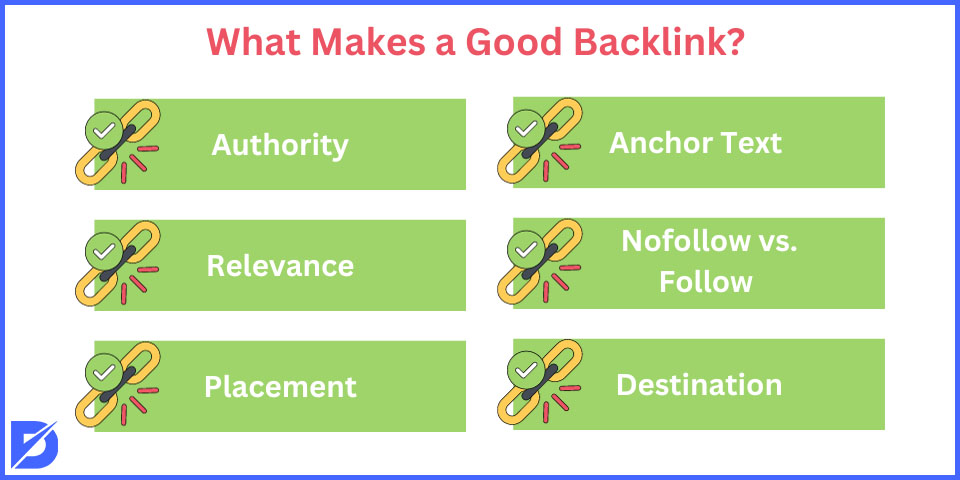
Authority
As we mentioned earlier, Google and some search engines consider links as ‘votes’ for the overall quality of the website. The higher the vote you have, the more chance your backlinks will have an impact on your rankings.
So, that means link building from a well-known, reliable source will gain you more ranking opportunities on SERPs. For example, a link from BBC or The Wall Street Journal is more likely to have a great impact on your rankings compared to a blog content link.
As tools, you can use Domain Rating (DR) and URL Rating (UR) to assess the popularity of the link you mentioned in your content earlier. Also, you can use Semrush’s Backlink Analytics tool to check for the authority score of each website you want to mention before actually putting them on the content. The higher the score, the better the chances.
Relevance
In the “How Search Works” guide, Google says: “Beyond looking at keywords, our systems also analyze if the content is relevant to a query in other ways. We also use aggregated and anonymized interaction data to assess whether Search results are relevant to queries…” So, that means you should not link everything you see with every chance you have.
Google uses relevance as a ranking factory in which it analyzes whether your links have been put consciously and knowingly in relatedness, or just for the sake of link building. Hence, for relevance, you should consider these two factors:
- Topical Relevance: The link building between two web pages should be topically related. When the content contextually fits, it enhances the vote and the value of the link itself. For example, a technological tool review can increase the value of a tech-related website while it can decrease the value of a page about yoga.
- Audience Relevance: You should also consider whether the website’s link-building audience is in line with your target audience. A link from a site that attracts your ideal visitors is more valuable since it can earn you more organic traffic.
Placement
According to Google, the place of a link decides the possibility of it being clicked on by the users and the readers. Hence, Google says the placement of a link is crucial for determining the authority of the link itself. So, we can recommend that when you put the backlinks in the main body or the upper parts of the content, it has a higher chance of being visited, therefore increasing the value of authority of the link and the website.
Anchor Text
If you don’t know what it is, “anchor text” means highlighted clickable text in the article or content that leads to a link to another page. In most cases, anchor text describes or rewrites the title of the linked source.
Google uses the anchor text to understand what the linked text is about and its definition. Hence, the better you describe the anchor text, the higher it will gain authority. For example, when the anchor text says “how to set up a TV”, Google will understand the link is about setting up televisions. However, if the anchor text just says “its website”, Google may not understand anything and may find it irrelevant. Hence, you should be careful about what you write when deciding on the anchor text.
Nonetheless, it is also important to note that you should not try to manipulate words for the sake of link-building and turn them into something irrelevant and meaningless. Google can suspect and understand malware and manipulation and can penalize you for that. So, it is better to keep going on with the basic but descriptive one.
Nofollow vs. Follow
- Follow Links: Follow or “do follow” links pass link equity. In other words, they contribute to your site’s authority and can positively impact both site’s SEO. These are the most common types of backlinks.
- Nofollow Links: On the other hand, nofollow links contain a “rel=nofollow” attribute and do not pass link equity. While they may not directly boost SEO, they can still drive traffic and enhance your site’s credibility. They are also important for a natural backlink profile for your webpage.
As a general rule, most users prefer and should prefer the following links because these are the ones that bring the strongest votes. However, if you have a chance, it is recommended to use nofollow links with popular, well-known people who don’t need authority votes in general. For example, you don’t need to do follow links with web pages like Wikipedia since all links are nofollow links on the page. Hence, if you have a chance to get a link, whether it is nofollow, take the chance since it will bring traffic to your website.
Destination
When you use link building on your website, there are three options of destination that a link will take you, which are your homepage, your linkable assets, and the actual page that you need to rank well on Google. Generally, the pages that you need to rank well are actually the hardest ones to get link building. So, you need to ensure that the destination page offers high-quality, informative, and engaging content in the link. Also, if you are thinking about user performance as well, your linked page should load faster and quicker.
90 Link-Building Strategies
Since we defined what link building isand why it is important, now we know we need to do link building in order to enhance organic traffic on our website. However, knowing is only the beginning. In this part of our article, we collected the best link-building strategies in SEO that can help you to do link-building effectively and successfully.
Technical Link-Building
In the link-building process, you should take some steps that will both increase your website quality and improve your website in terms of technical SEO. There are also some important terms you need to know for link-building.
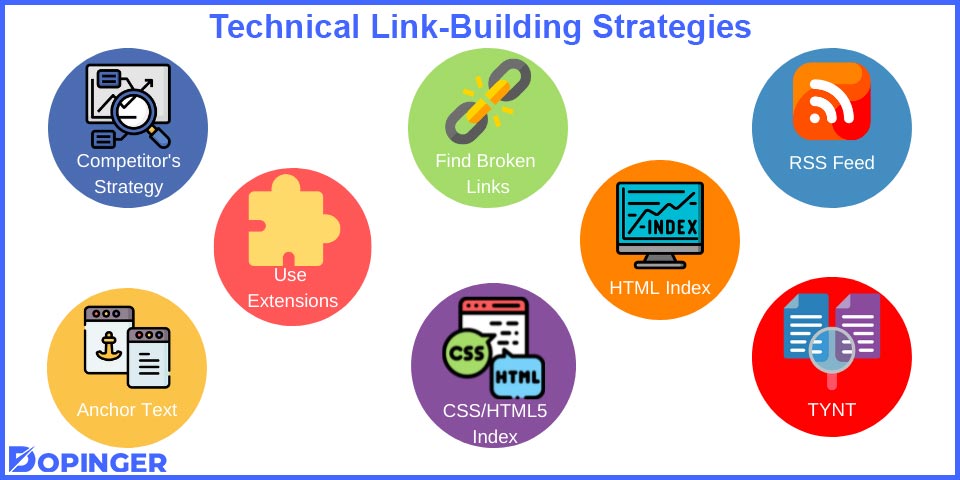
- Use Competitor’s Strategy
After you analyze your competitors, also you can analyze their strategies. It is okay to imitate your competitor’s strategies. With the help of analyzing, you can see how many backlinks your competitors have, why they are number one, and which sources they use. Hence, you can create a new strategic plan by pursuing the links they use and, therefore, achieve successful link building for your website.
- Anchor Text
Anchor text is the name given to a clickable link of a word or phrase on a website. All links you give or get are made with this system. The anchor text you use while building links must be relevant to the page it sends.
- Find Broken Links
With this strategy, you can find broken links and use their links on your website.
- Use Extensions
There are a lot of extensions for link-building to make your job easier. You can use them to analyze websites, find broken links or new topics, etc.
- HTML Index
Your website and webpages must be indexed for your site to be found by search engine bots and for your links to work.
- RSS Feed
It is a dataflow that makes it easy to follow websites with blogs or online magazines. It allows you to follow the content added to a website without entering the site. Therefore, providing links will be an action you do for your readers.
- CSS/HTML5 Index
The more organized your website’s codes are, the more easily search engine bots will find and examine your website. The visibility of your website is essential in the link-building process, and the organized code structure will make you stand out.
- Link baiting
It is a content method that attracts people’s attention, and wants to share it voluntarily. You can get backlinks organically, as Google suggested, with this method.
- TYNT
Unfortunately, your content can be stolen from other websites. In this situation, you can TYNT tool. It automatically puts your link under the content because someone uses your content without your permission. Therefore you will get backlinks thanks to this strategy.
- Set up 301 redirects
Permanent redirects you make on your site are called 301 redirect. Thus, you can easily reach visitors to different links with redirects between pages.
- Robots.txt
It is a text file that tells search engine bots which pages they can and cannot access. For example, you closed the robots.txt file of the web page from which you got links. Still, search engine bots can index the webpage with these links.
- Dofollow Link
The backlinks you get from reliable and authoritative websites are marked with this tag so that Google is notified that you are referencing the linked site.
- Nofollow Link
Untrusted websites are marked with this tag. Therefore, even if search engine bots visit this link, it has no effect.
Link-Building with Content
The most significant part of link building goes through the content part. Most of the places where you will get or give links will be your content.

- Create Blog Post
If you want to build links to your website, you have to have blog posts. You will get most of the backlinks thanks to your blogs, and you can add internal links to your blog. You can work on skyscraper blogs, which mean long-form and informative articles that delve into already existing content. It aims to outperform the existing content on a specific topic and attract links with the detailed form. These posts are called “skyscrapers” because they are designed to be longer, or like taller buildings, and more ostentatious than their competitors.
- Promote Your Content
When you create content, you should promote it. People can find your content on many different platforms and share it. It will increase your website traffic.
- Create High-quality and Long Blogs
You need to answer the people’s questions in detail. Moreover, your content should be worth sharing. The readers can promote your content in this way.
- Writing about trend-topics
Recent topics will be remarkable for people, and these types of content tend to be searched by people.
- Create Evergreen Content
Evergreen content always means fresh topics. People can search for these topics for years. So, when you get a backlink for your evergreen content, it will be fresh for years.
- Make Lists like “Best of”
All listed articles promise readers an easy and fast reading experience. Therefore it helps your link-building by attracting more readers.
- Create “How to” Blogs
Many people find answers to their questions thanks to Google featured snippets, and these questions’ type is “how to” most of the time. How-to guides are basically instructions on a specific topic, product, or situation. They explain everything in a step-by-step format. Hence making it more understandable to the audience. As we all are familiar with those content, we can understand why they are considered ‘linkable assets’. Since they have practical usage and value for the users, they can be linked to any content that is also talking about the same product or a topic.
- Find Topics from People’s Questions
If you can give valuable answers to people, they will tend to share your blog posts, and you will get backlinks in this way.
- Use Quora

Quora is a social website based on questions and answers. The users ask questions, and people give answers. You can find new topics for your blog that might interest people.
- Write About Myths
Many people have right-known wrongs. The correct answers will be attractive to them.
- Be Authority on Specific Topics
Let’s say you have a website about digital marketing, which is a wide range topic. If you focus on specific topics like ‘promoting a company, you may be the first website that comes to mind on this subject. Being authority brings many backlinks.
- Follow the Updates
You should catch the updates so that you can write about them. Your blog post may be the reference when people need information about the updates. Updating existing articles, guides, or resources with new data, figures, or insights is called updating outdated content. Obsolete content can harm your credibility and relatedness with time, as users generally need current resources for specific topics. Thus, updating them regularly can ensure that they are accurate and relevant to the current ongoings. Moreover, updated material can help you maintain or raise your search engine rankings since modern content is preferred by search engines.
- Case Study
Helpful articles tend to be referenced for the other blogs so that case studies might help link-building. They are usually supported with data and evidence from the other cases. These real-life case studies generally focus on the problem, solution, and results of the solutions they provide.
- Create Viral Content
It will increase your website’s traffic because people love viral content since social media is widespread, and this type of content should be shared to be viral.
- Write News Articles
It is similar to the following updates.
- Book Blog
You can choose a book relevant to your website and examine it. You can share your book blog with the writer.
- Add Slide
Different types of content can be shared on different platforms. You can create slides, and you can share them on websites for slides.
- Use HARO

HARO (Help A Reporter Out) is an online platform for getting feedback. You can share your blog and get feedback from people—two birds with one stone.
- Use Digg
Digg is a website for sharing new stories. It helps for interesting topics that people may like.
- Tool Collections
Tool collections are similar to the lists. It is valuable content for people, and you can send your article to the tool owner.
- Use Call-to-Action Quotes
Writing call-to-action quotes will give a fillip to the readers for sharing. “Learn more here”, “buy now”, and “share on social media” are some Call to Action examples.
- Repromote Your Blogs
You must repromote your blogs, especially for your backlinks. Your website should be up-to-date with high traffic.
- Create Beneficial Graph or Data
The websites may want to use your graphs or reports. Then, they have to give backlinks.
- Convert Your Content to Different Formats
Every type of content can be used on different platforms. It means backlinks from many websites.
- Press Release
It is similar to the following updates or writing news articles. Giving information about updates makes your content valuable.
- Translate Your Content into Second Language
To build links worldwide, you should create content in other languages.
- Guest Blogger
Famous bloggers will come with their readers. You can invite a blogger or be a guest blogger on other websites. It is an impactful way for backlinks.
- Write Articles to Be Used as A Source
When you create helpful content, people may use them as a source. You must want backlinks if you find a website that uses your sentences or visuals.
- Add Internal Links
Link-building does not mean just backlinks. Also, you need internal links. You can give links to your other blog posts or your services.
- Indexing Your Content
Indexing is the collection of documents. When you publish your blog post, you have to index it on Google for visibility. Moreover, there are websites like a collection that contain glossaries and indexes. You can add your blog posts to these websites for indexing.
- Add Infographics
Infographics are very beneficial for increasing traffic and promoting your blog posts. You can share them on visual-based social media platforms such as Pinterest. Moreover, other websites may want to use them.
- Outbound Link
You should be careful when choosing a website for an external link. Their authority must be high.
- Add Value Links
You should be selective when you add internal or external links to your website. They need to serve the readers.
- Add Relevant Internal Links
On-page links should be relevant to your content and shouldn’t reduce the quality of the article.
- Choose High-Authority Websites
Before you add links to your blog, you need to analyze the websites in terms of domain age and authority of the websites. You must choose high-authority websites.
- Don’t Add More Than 3 Links to Your Article
The number of on-page links may vary depending on the article’s length, but adding more than three links in an average article will be too much.
Link-Building with Social Media
The easiest way to reach and communicate with the reader is through social media platforms. The more active you use your account, the more links you will get.
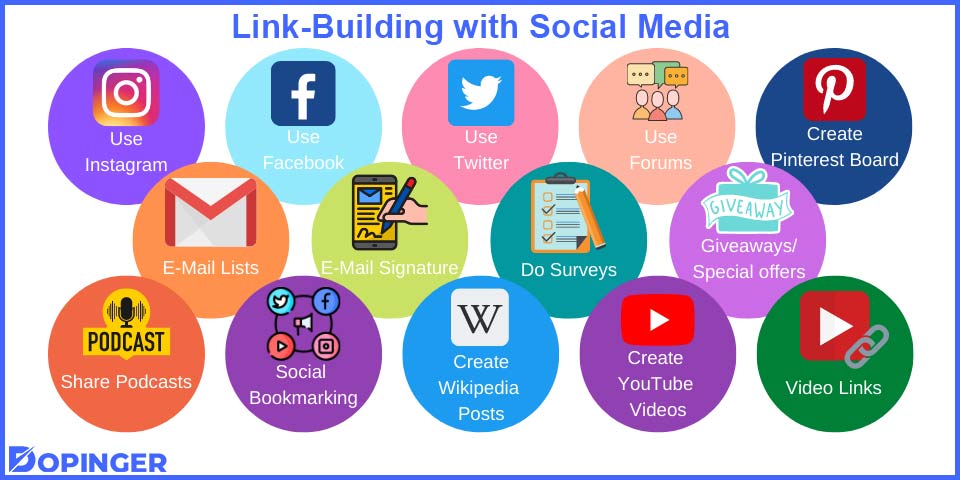
- Use Instagram
You can share your website and content on Instagram. If you want to share the story, add an image and your blog post’s link, or you can share a post with a link. Don’t forget to write your website’s link on the bio.
- Use Facebook
You can share your Instagram and Facebook posts in sync. You must add your links to the posts.
- Use Twitter
When searching on Google, you can see tweets on SERP. It is a simple way for link-building with high visibility. You can share your blog posts, and people can share quotes from your blogs.
- Use Forums
You can answer questions or add a topic to the forums. It will provide to create your community. Moreover, you can find your target audience.
- Create Pinterest Board
You can use your infographics or graphs on Pinterest by adding your website’s link.
- E-mail List
After you make any update on your website, send it to the mailing list you created. You can add a button to your website to join the list.
- E-mail Signature
Add your website link to your stable personal information at the bottom of the e-mails you send.
- Do Surveys
Do surveys on social media or on your website if you want to research. Therefore, you can have special data, and people may need this information.
- Make Coupon Codes/ Special Offers/Giveaways
Coupon codes or giveaways usually have some rules for attending. These rules are examples of sharing posts or links, tagging people, and commenting.
- Podcasts
You can build website authority thanks to podcasts. You can share your podcast with social media platforms or websites for podcasting, and you will get backlinks. In addition, it provides a chance to promote your blog.
- Social Bookmarking
You can get index and backlinks by sharing your website’s content on social bookmarking sites with keywords and URLs.
- Create YouTube Videos

YouTube is the most popular video-sharing platform, so you should convert your blogs to videos. You should add relevant links to your posts.
- Wikipedia Posts
You can write articles on Wikipedia like guest blogging and add links to your articles.
- Video Links
There are many video websites. Adding video links on the page will help earn links.
Networking for Link-Building
The network you will get by getting to know people in your industry is an important way in the link-building process.
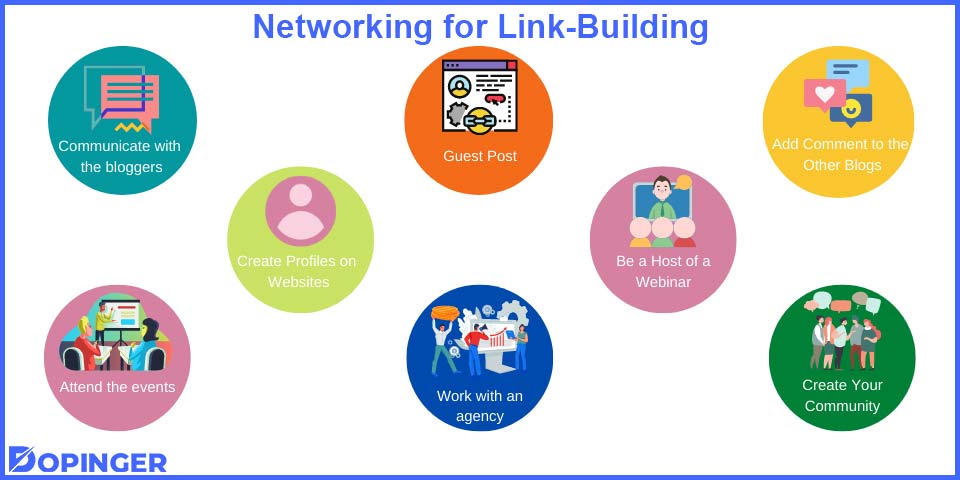
- Communicate with the Other Bloggers
You should stay in touch with other bloggers who write about similar topics to your website.
- Guest Post
As we mentioned before, inviting other bloggers to your website is possible, and it is free. On the other hand, you can pay to publish your article for promotion on other websites.
- Add Comments to the Other Blogs
You can add comments to the other blogs if there are similar blog posts like yours. It must be relevant. High-traffic websites will help you for boosting your website.
- Create Profiles on the Other Websites
After you create a membership on the other websites, you can add your website link to your bio.
- Write Product Reviews
Companies may give backlinks to your product reviews for their promotion when you send them your blog post. If you have products, you may want product reviews from other bloggers.
- Introduce Yourself to The Famous Bloggers
Having famous bloggers around you will help you develop continuously in the network.
- Request Website Review
Other bloggers may give you feedback, and you can get backlinks.
- Be a Speaker at the Event
When you are a speaker at the event, you can have a chance to introduce your website.
- Be a Host of a Webinar
Organizing a seminar might be chargeable and challenging for people who want to participate. However, you can organize a webinar that is online and affordable. It is an excellent chance to meet other bloggers.
- Be a Sponsor for Events
It is the best way to make your company’s name known.
- Participate in a Blog Community
You can share your blogs with other bloggers in a blog community.
- Communicate with your Entourage
You share your posts on social media, so why can’t you share them with your friends too? They can find networks for you, or they can promote themselves.
- Attend the Events Where Digital Marketers Come
Regardless of the sector, you should know about digital marketing if you have a website. At this point, it will be beneficial to attend a seminar where digital marketers come and meet them and promote your website.
- Work with an Agency
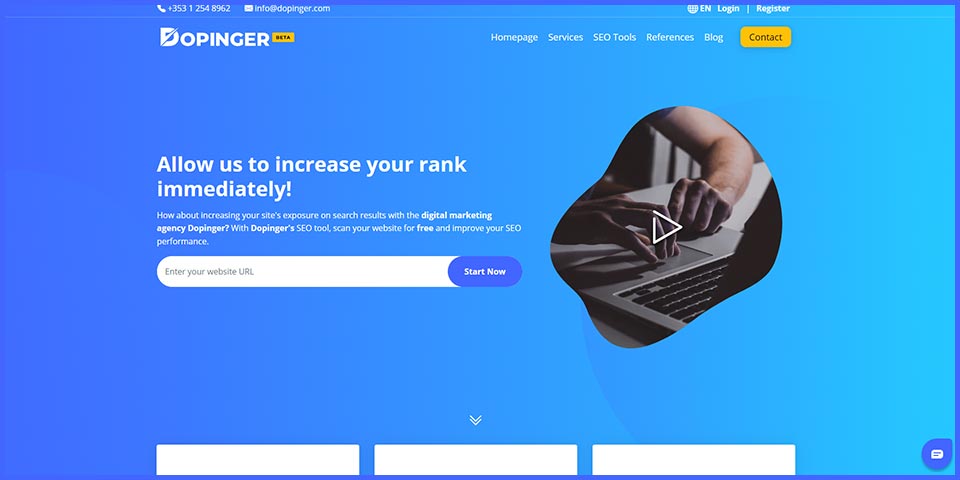
You can just pay and build links with a professional agency.
- Communicate with Influencers
Most social media users follow influencers and their effects more than you can imagine. Sending a link to a strong influencer is an efficient strategy. Try to benefit from influencer marketing.
- Send E-mails for the Backlink.
If you find a high-authority website and you want to get backlinks, you can send e-mails to it.
- If You Don’t Get a Response, Politely Repeat The Process
Even though you send an e-mail, not getting a response is expected. Kindly try your luck again.
- Offer Corrections to Other Blogs
If you find some mistakes, such as grammatical errors, in other blogs, you can offer corrections and get backlinks for them.
- Offer to Update Other Blogs
Some blog posts may not be up-to-date. You can contact blog owners to update their old posts.
- Create your Community
You can design a website where people can create a membership and share their comments.
Analyze Your Website for Link-Building
You must analyze your website to get backlinks because the website owners will choose high-authority and high-traffic websites.
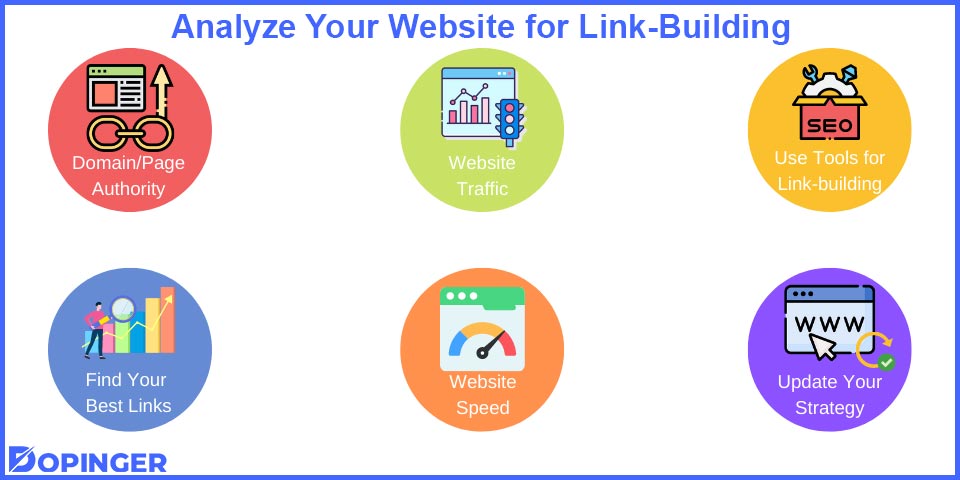
- Domain Authority
Domain authority means your website’s relevance to a specific industry. The results will give a reliability score and your website’s visibility on search engines. A website with more links has more authority than a website with fewer links.
- Page Authority
Do you know how your page ranking on search engines? If you don’t, you should learn your PA by Moz. You can see specific web page performance on your website.
- Website Traffic
When you have high traffic on your website, it will be valuable for backlinks. If you want to increase your preferability, your website’s traffic is an essential element.
- Use Tools for Analyzing
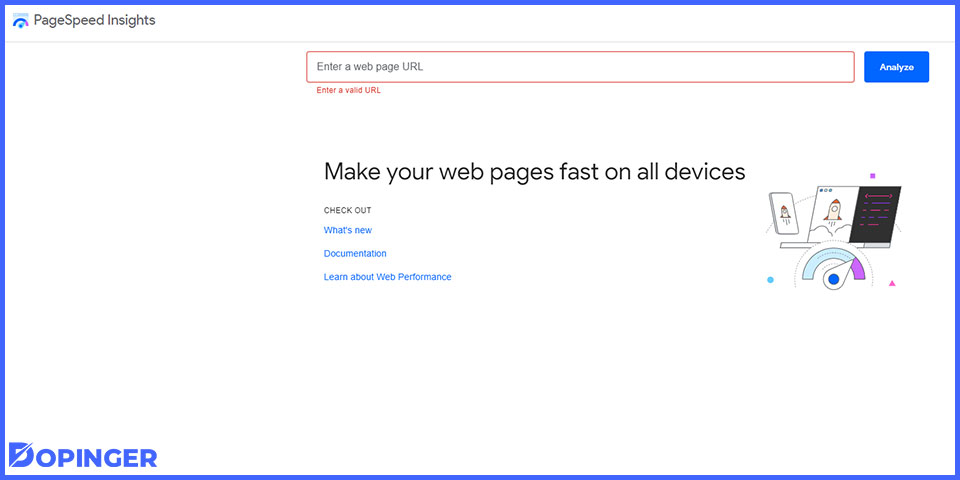
Many valuable tools for analyzing your website performance include Google Search Console, SEMRush, Ahrefs, Google PageSpeed Insights, etc. Moreover, there are link checkers such as Broken Link Checker.
- Find your Best Links
You add many links to your blog posts, and you can analyze the best links for your website at the end. For example, you can examine the heat map to understand which link readers are most likely to click on.
- Website Speed
People leave websites if they can not access them in 5 seconds. Thus, you need to know your website speed to be selected from other websites.
- Update Your Strategy According to the Results
If there are some problems in your analysis reports, you should solve them immediately not to lose backlinks.
How To Track Link Building Results?
When everything is done, your job is still not done because effective link-building outreach requires patience, persistence, and a respectful approach. You should still be careful and cautious about the afterward process. You can track the open rates and click-through rates of your outreach emails using email tracking tools. This can assist you in evaluating the impact of your subject lines and content. You should also keep a log of your outreach activities, including the websites you contacted, the responses you got, and any backlinks you got. This enables you to effectively monitor your progress and see which one is working for you. And lastly, you should analyze the outcomes of your outreach efforts frequently and change your strategy if the current one does not respond to your needs and your target audience.
Timeline
Link-building tips are one thing. Applying them in a timely fashion is another. You will need to monitor specific components at certain intervals, and these tend to be different from one another. What this means is that you won’t have to do every task listed every day. You will instead have to proceed mostly in weekly terms. Here’s an overview of the timeline that you may adopt:
Weekly Monitoring
Starting from your initial steps, you need to do a few things weekly. For instance:
- Conduct internal, and competitor backlink audits.
- Browse link opportunities. This is something to be done almost weekly since the link-building market is growing.
- Choose the most appropriate outreach method depending on the prospect’s profile (e.g., email).
- Think about new topics and start building content accordingly. Indeed, posting regularly is a must.
- Submit your content to your target/host website and wait for feedback.
Monthly Monitoring
- Keep remaining in touch via social media or email. It’s always a good idea to “check-in” and reminds of your existence to your prospects.
- Verify mentions. Google Alerts is one way to do it. The objective is to count and evaluate the current state of brand mentions, competitor mentions, and such.
- Consider content syndication as a possible bonus. If you find the right publishers, this can become a new way to revive and even “immortalize” your content.
- Check reviews and testimonials. This is not only to get a glimpse of your online image. It can also act as an extra for new link-building opportunities.
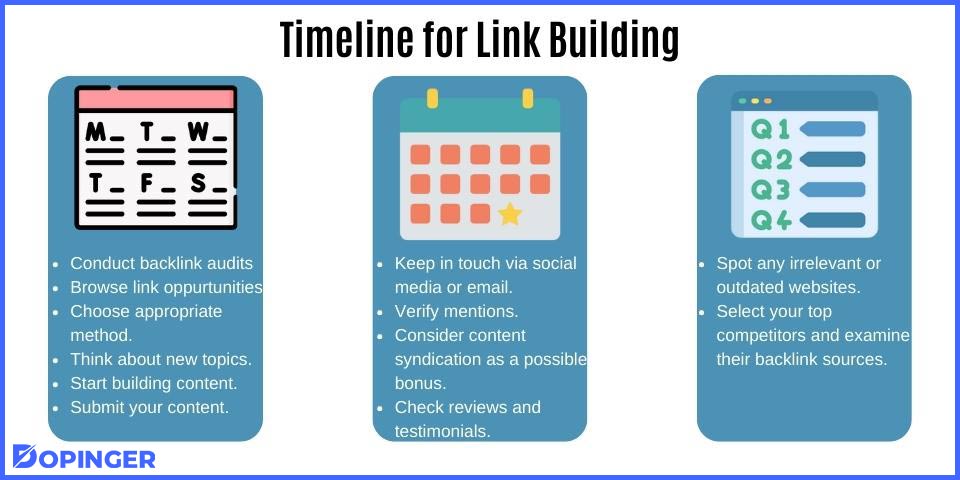
Quarterly Monitoring
This one is about carrying out a broader evaluation of your overall strategy. This is also the maximum interval to review technical aspects. Waiting any longer is usually not recommended. Basically, what you need to do here is to run through almost your entire checklist. The most important part is the audit of your backlinks. You may do it through Google Search Console. Spot any irrelevant or outdated websites. Then transfer them to your disavow list.
Also, this is a good interval for a more detailed competitor analysis. Select your top competitors and examine their backlink sources as well as their strategy. No need to be greedy here. If you can just pick 3 or 4 brands and manage to investigate them fully, that’s already huge. The goal is not to 100% reproduce what they are doing but rather to get inspired and informed.
What to Avoid in Link Building?
As we talked about through our guide, link building is significant for SEO efforts and brand awareness. However, it is also a strategy that is open to mistakes. Everyone can make mistakes. However, thanks to our comprehensive guide, now you will know what to avoid in link building to achieve success.
- Building links from low-authority websites: The authority of a website is determined by a number of factors, including the number of backlinks it has, the quality of its content, and its age. When building backlinks, it is important to focus on high-authority websites. These websites are more likely to pass on their authority to your website, which will help to improve your search engine ranking.
- Building links from irrelevant websites: As we said lots of times in our guide, relevance is key in link building. It is important to build links from websites that are relevant to your own website. This will help to improve the relevance of your website in the eyes of search engines.
- Building links using automated tools: Automated link-building tools can be tempting since they ease the process a lot. However, they are often ineffective and can even damage your website’s reputation. Instead, focus on building links manually through outreach and guest blogging.
- Over-optimizing your anchor text: In link building, it is important to use a variety of anchor text rather than just using the same keyword over and over again. This will help to make your backlink profile look more natural.
- Building links too quickly: You should build links gradually over time. Building too many links too quickly can actually hurt your website’s ranking since it is an unnatural pace of link building.
Link Building Tools
When it comes to link building, there are hundreds of tools that can help you analyze and find links. Thanks to those tools, you can find opportunities like broken link building and manage your backlink profile.
Here’s a list of some popular link-building tools that you can benefit from;
- Ahrefs
- SEMrush
- Moz
- Majestic
- BuzzStream
- Ninja Outreach
- Hunter
- Google Search Operators
- Google Alerts
1. Ahrefs
Ahrefs is a comprehensive SEO tool that provides profound backlink analysis, competitor research, and keyword tracking. It allows you to find link-building opportunities and track your link-building progress. Moreover, you can also monitor your competitors’ backlink strategies and create a new strategy for yourself.
2. SEMrush
Similar to Ahrefs, SEMrush offers a collection of SEO tools, including backlink analysis, competitor research, and keyword research. It can help you identify potential link partners and track your rankings.
3. Moz
Moz’s Link Explorer provides insights into your backlink profile, including spam score analysis and link opportunities. With its help, you can avoid spam and create more natural backlink contexts. You can also pay for Maz Pro and benefit from premium SEO tools for link building and website optimization.
4. Majestic
Majestic is specifically designed for backlink analysis and offers a Trust Flow and Citation Flow metric to evaluate the quality of links. Since the quality of links is crucial for rankings, it can help you discover link-building opportunities and assess the authority of websites.
5. BuzzStream
BuzzStream is a link building and outreach platform that helps you find influencers or website owners for outreach link building. You can manage outreach campaigns and track your progress from that platform. It also offers email templates, relationship tracking, and project management features for SEO efforts.
6. Ninja Outreach
Ninja Outreach is an influencer marketing and outreach tool that assists with finding potential link building partners and bloggers. What is better about Ninja Outreach is that it provides templates for outreach emails and campaign management features.
7. Hunter
Hunter assists you in finding email addresses associated with websites, making it easier to reach out to potential link-building partners. You can find the right person to contact easily and create well-written emails for them. It also comes with a Chrome extension for quick email discovery.
8. Google Search Operators
While not a tool per se, Google’s search operators allow you to conduct advanced searches to find link-building opportunities. For example, you can use “site:domain.com” to search for all pages on a specific domain.
9. Google Alerts
As we said earlier, you can set up Google Alerts to receive notifications when new content or mentions related to your industry or niche are published. This can help you discover potential link-building opportunities. Also, if someone mentions you without giving links, you can find them with Google Alerts and contact them to fix the situation.
Build Your Links with Confidence
Now that you know about (or have been reminded of) the importance of link building for SEO, it’s time to get to work. A checklist will ensure that you do things in the right order. In effect, backlink crafting can sometimes be tedious since it requires control of many diverse aspects. That being said, if you follow our guidelines, you should be able to start getting significant results in a short while. What results? Increased visibility, recognition within your niche (and beyond), and authority. In sum, the ultimate stairway leads to higher traffic and thus to better rankings.
If you find this article helpful, check out The Worst Link Building Techniques as well!
Frequently Asked Questions About
Why wouldn’t you benefit from a handy tool? A link-building checklist allows you to sort everything out and control all the important aspects at a glance. It acts as a memory aid. Who would complain about having one?
The tips given in our article address beginners as much as more advanced SEO practitioners. Make sure to read them all. In case of a doubt, you can also contact specialized SEO agencies.
No, and it’s unlikely that it will die soon since we are discussing a networking strategy. Backlinks are what maintain alive the connections in that network.
We would rather say that they are all complementary. For example, guest posting can lead you to new partnerships. These can familiarize you with new directories and even experts. All this means you increase your chances of having places from which you can reclaim broken links. As you see, one thing always leads to another.
Backlinks are nothing but proof that other websites do trust yours. This is likely to have a positive impact on your domain authority and, consequently, your ranking.

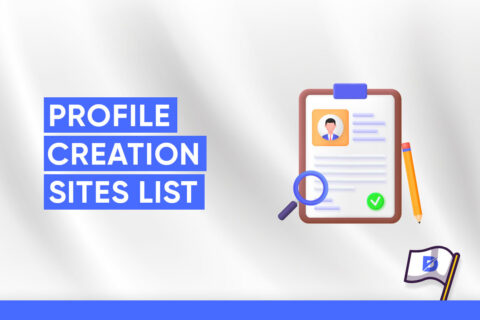
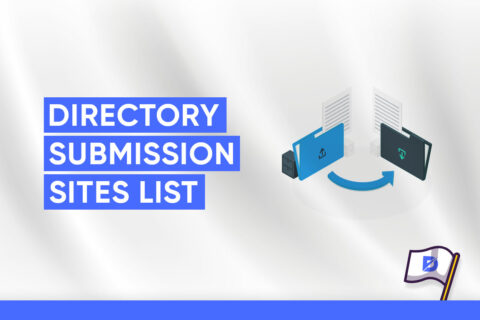

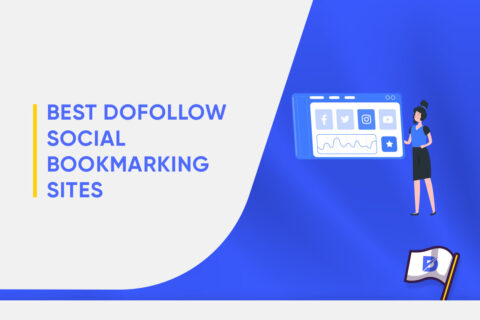
No comments to show.